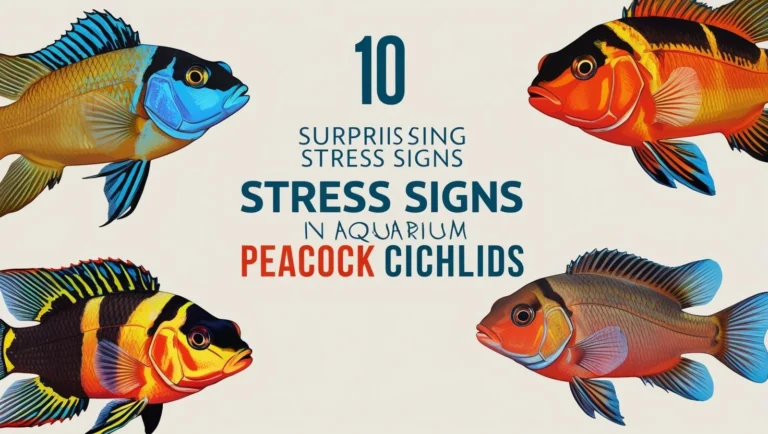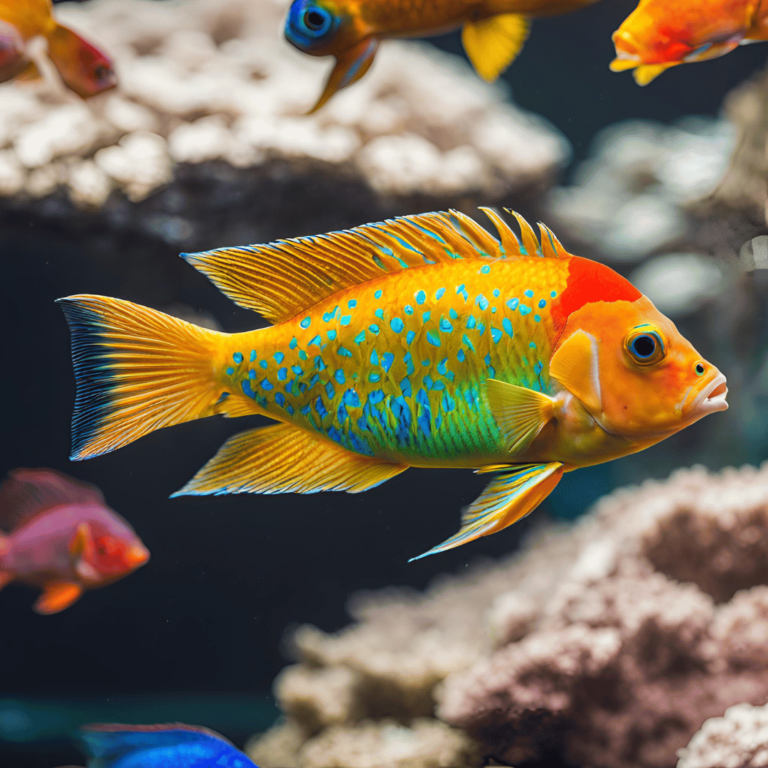Your trusted guide to cichlid care, tank setups, and quality products.

Peacock Cichlid Colors: 5 Stunning Varieties You’ll Love
Immerse yourself in the vibrant world of peacock cichlid colors and varieties! Our comprehensive guide explores the stunning hues, unique patterns, and fascinating differences between various species. Discover the beauty and diversity of these captivating fish.
Image credit: Canva
Peacock cichlids are among the most stunning freshwater fish you can add to your aquarium. Known for their dazzling array of colors, these African cichlids are a favorite among aquarists, both beginners and experts. But what makes these fish so colorful, and what are the different peacock cichlid color varieties available in the hobby?
In this guide, we’ll explore the science behind peacock cichlid colors, the most popular varieties, and how to enhance their natural beauty in your aquarium. Whether you’re new to the hobby or an experienced aquarist, this comprehensive guide will deepen your appreciation for these vibrant fish.
At PeacockCichlid.com, we believe in transparency and honesty with our readers. Some of the links in this article are affiliate links, which means we may earn a small commission if you make a purchase through them—at no additional cost to you. These commissions help support our site, allowing us to continue providing expert advice, in-depth guides, and valuable content for Peacock Cichlid enthusiasts like you.
We only recommend products that we trust and believe will be beneficial for your aquarium. Thank you for your support!
Why Peacock Cichlid Colors Are So Vibrant
Peacock cichlids, native to Lake Malawi in Africa, owe their vibrant colors to a combination of natural selection, environmental factors, and genetics. These colors serve both aesthetic and functional purposes, making them a marvel of nature.
Natural Habitat Influence on Peacock Cichlid Colors
The crystal-clear waters of Lake Malawi allow light to penetrate deeply, which highlights the natural colors of peacock cichlids. Their bright hues help them stand out during mating displays and territorial behaviors, giving them a competitive edge in their environment.
Genetic Factors Behind Peacock Cichlid Colors
Over time, breeders have enhanced these natural colors through selective breeding. This process has given rise to an even more diverse palette of peacock cichlid varieties in the aquarium trade, offering aquarists a wide range of options to suit their preferences.
Popular Peacock Cichlid Color Varieties
There are several stunning color varieties of peacock cichlids, each with its own unique combination of hues and patterns. Here are some of the most popular types that aquarists love to showcase in their tanks:
1. Red Peacock Cichlid (Aulonocara Rubescens)
The red peacock cichlid is famous for its vibrant red or orange coloration, making it one of the most sought-after varieties. This variety was selectively bred to bring out its deep red tones, which are especially vivid in male specimens. Its striking appearance makes it a standout addition to any aquarium.
2. Blue Peacock Cichlid (Aulonocara Nyassae)
One of the most iconic types, the blue peacock cichlid displays an intense metallic blue color. This variety stands out in any tank, and its shimmering scales make it a favorite for aquarists looking for a fish that demands attention.
3. Sunshine Peacock Cichlid (Aulonocara Stuartgranti)
With its golden-yellow body and contrasting blue highlights, the sunshine peacock cichlid truly lives up to its name. The warm, bright colors of this variety bring a vibrant touch to any aquarium, adding a sense of tropical brilliance.
4. Dragon Blood Peacock Cichlid
A hybrid variety, the dragon blood peacock cichlid is known for its unique pinkish-red or orange coloration. Bred specifically for its distinctive appearance, this variety doesn’t occur naturally in the wild, but it has become extremely popular in the hobby due to its striking colors.
5. Ruby Red Peacock Cichlid
Another selectively bred variety, the ruby red peacock cichlid boasts an intense ruby-red hue. Its bold coloration and relatively peaceful temperament make it a favorite among aquarists seeking a dramatic centerpiece fish.
The Role of Peacock Cichlid Colors in Behavior
The bold colors of peacock cichlids aren’t just for show; they play an important role in their behavior and interactions.
Mating Displays
Male peacock cichlids display their bright colors to attract females during mating. The more vibrant the male, the more likely he is to impress a potential mate, increasing his chances of reproduction.
Dominance and Social Hierarchy
Color intensity can signal dominance within a group of peacock cichlids. The brightest males are often the most dominant, and their vivid hues serve as a warning to other males to keep their distance.
Factors That Influence Peacock Cichlid Colors
The color intensity of your peacock cichlids isn’t set in stone. Several factors can enhance or dull their natural colors, giving aquarists some control over how vibrant their fish appear.
Diet for Enhancing Peacock Cichlid Colors
A nutrient-rich diet is essential for bringing out the best in your peacock cichlid colors. Foods high in carotenoids, such as spirulina and krill, can boost red and orange tones. Protein-rich foods also help intensify their overall coloration, ensuring your fish look their best.
Water Quality and Peacock Cichlid Colors
Keeping your water parameters in check is crucial for maintaining vibrant colors. Peacock cichlids thrive in slightly alkaline water (pH 7.8-8.6) with temperatures between 76-82°F. Poor water conditions can dull their colors, so regular water changes and monitoring are essential.
Lighting to Showcase Peacock Cichlid Colors
Proper aquarium lighting can make a world of difference when it comes to showcasing the colors of peacock cichlids. Full-spectrum LED lighting designed to enhance the natural hues of fish will bring out the best in your tank, making your peacock cichlids’ colors truly pop.
Breeding and Creating New Peacock Cichlid Color Varieties
Selective breeding has allowed aquarists to develop new peacock cichlid varieties with even more intense and unique color patterns. Breeders have successfully created hybrids, like the dragon blood and ruby red varieties, that display colors not found in the wild.
New varieties continue to emerge, and hybridization allows aquarists to enjoy a greater range of colors in their tanks. However, it’s important to ensure that hybrid peacock cichlids are kept with compatible tank mates, as hybrids may sometimes have different behaviors or care needs.
Tips for Maintaining Vibrant Peacock Cichlid Colors
- Provide a Balanced Diet: Include high-quality foods rich in carotenoids and proteins to enhance their natural hues.
- Maintain Optimal Water Conditions: Regular water changes and consistent monitoring of pH, hardness, and temperature are essential.
- Invest in Quality Lighting: Use full-spectrum LED lights to bring out the vibrant colors of your peacock cichlids.
- Avoid Stress: Keep tank mates compatible and maintain a stable environment to reduce stress, which can dull their colors.
Conclusion
Peacock cichlid colors are a testament to the beauty and diversity of nature. Whether you’re captivated by the rich red of a red peacock cichlid or the electric blue of a blue peacock cichlid, there’s no denying the appeal of these stunning fish. By understanding the factors that influence their coloration—like diet, water quality, and genetics, you can ensure your peacock cichlids are always looking their best.
With so many color varieties available, you can mix and match to create a truly breath taking aquarium display. Love peacock cichlids and their vibrant colors? Share this guide with other aquarists and spread the word about the beauty and variety of these stunning fish.
Enhance your understanding of these vibrant fish by exploring more of our expert guides on peacochcichlid.com. If you’re curious about maintaining those brilliant hues, be sure to check out 7 Powerful Reasons Behind Peacock Cichlid Colour Loss for insights on preserving their stunning colors. You may also find our article 10 Signs of Peacock Cichlid Stress and How to Prevent It invaluable for creating a calm, healthy environment that supports both color and behavior. For those just beginning their peacock cichlid journey, Peacock Cichlid Care: 7 Powerful Tips for Beginners offers a great starting point to ensure long-term success.
We invite you to visit us again for more expert advice and updates, and don’t forget to follow us on social media to stay connected with the latest tips and trends in peacock cichlid care!
FAQ’s
What makes peacock cichlid colors so vibrant?
Peacock cichlid colors are influenced by their natural habitat, genetics, and environmental factors. The clear waters of Lake Malawi highlight their hues, while selective breeding enhances these vibrant colors further.
How do peacock cichlid colors differ from other cichlids?
Peacock cichlids are known for their metallic and bright colors, such as blue, red, and gold. Other cichlids may have more subdued or patterned coloration depending on their species and habitat.
Can diet improve peacock cichlid colors?
Yes, a nutrient-rich diet, including foods high in carotenoids like spirulina and krill, can intensify the colors of peacock cichlids. Protein-rich foods also help maintain their overall vibrancy.
What are the most popular peacock cichlid color varieties?
Popular varieties include red peacock cichlids, blue peacock cichlids, sunshine peacock cichlids, dragon blood peacock cichlids, and ruby red peacock cichlids. Each offers unique and stunning hues.
How do water quality and lighting affect peacock cichlid colors?
Peacock cichlids thrive in alkaline water (pH 7.8-8.6) with stable temperatures (76-82°F). Full-spectrum LED lighting can enhance their natural hues, while poor water conditions may dull their colors.
Do peacock cichlids’ colors change over time?
Yes, their colors can become more vibrant as they mature, particularly in males. Factors like diet, water quality, and stress levels also influence coloration changes.
Can peacock cichlids be kept with other cichlids?
Peacock cichlids can cohabit with other cichlids of similar size and temperament. However, avoid pairing them with overly aggressive species to maintain a stress-free environment.
How do peacock cichlid colors affect their behavior?
Colors play a role in mating and dominance. Vibrant males use their colors to attract females and assert dominance in their group, signaling other males to keep their distance.
What are hybrid peacock cichlids, and how are their colors unique?
Hybrid varieties, like dragon blood peacock cichlids, are bred for unique colors not found in the wild. These hybrids often display pinkish-red or orange hues, making them popular in aquariums.
How can I ensure my peacock cichlids display their best colors?
Maintain a balanced diet, optimal water conditions, and appropriate lighting. Reduce stress by providing compatible tank mates and a stable environment, ensuring their natural beauty shines through.



